Beautiful decay revisited (Art vs. Graffiti)
The Detroit Blog is (yet another) interesting blog by someone who besides writing about city revitalization issues, makes a habit of entering vacant buildings, and discusses these issues in a creative way. (There are a couple other Detroit-based websites that cover similar ground, such as the pathbreaking The Fabulous Ruins of Detroit.)
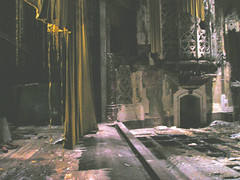 "Now Showing," the United Artists Building in Detroit. Detroit photos from Detroit Blog.
"Now Showing," the United Artists Building in Detroit. Detroit photos from Detroit Blog.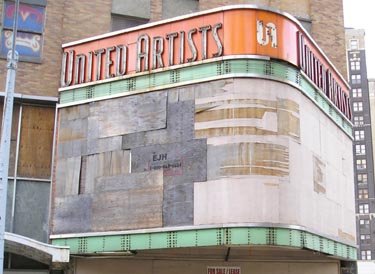
Despite 55 square miles of vacant land, Detroit still has "a lot" of vacant buildings. (All the more reason for urban growth boundaries to recenter development towards the core.)
An entry from December, "Paint it Black" discusses how the United Artist building, owned by the Illitch Family (they own the Detroit Tigers, and have invested a lot of money in rehabilitating buildings, particularly theaters, in Downtown Detroit [although they were not the first, the person who kept historic theaters alive for many years ended up being "forced" to sell some of his prime properties to Illitch]), is being cleaned in advance of the Superbowl, to be held in Detroit next month.
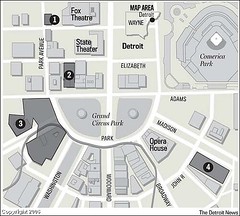 Illitch Family Projects. Image from the Detroit News.
Illitch Family Projects. Image from the Detroit News.Also see "Ilitches lift city hopes: Family plans to revive downtown properties, accelerating Detroit's recovery past Super Bowl.")
From Detroit Blog:
Crews went to work on the United Artists building on Bagley this week, perhaps as part of many pre-Superbowl cover-ups of the city’s warts... They also began undertaking the monumental task of removing or covering the innumerable graffiti paintings on the windows that made it one of the more stunning abandoned buildings in town.
Several years ago, someone basically set up shop in there and spent countless hours painting Mayan symbols on the windows, along with references to the year 2012, the end of the Mayan long-count calendar and an end-of-the-world date common in doomsday scenarios.
Of all the graffiti around town, this is perhaps the most tolerable. They didn’t paint over the pretty brickwork, but instead used the windows, which not only would be replaced with modern windows in any renovation, but are the most visible location for graffiti, since backlighting from the sun often makes them glow as if they’re fluorescent, creating a stained-glass effect.
The paintings were also a thumb in the eye of Mike Ilitch, the building’s owner, who purchased the building from the city and then left it wide open, as if to hasten its demise. Graffiti artists and vandals accepted his tacit invitation and basically moved in. The elaborate and remarkable graffiti made his towering abandoned skyscraper a tourist attraction, drawing suburbanites and tourists to view a constant mockery of his neglect.
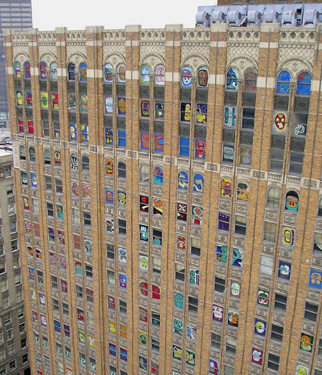
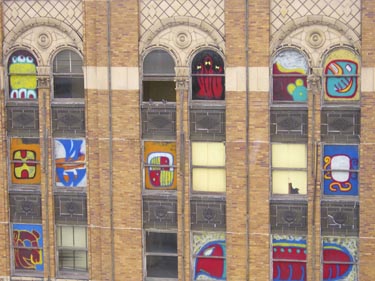
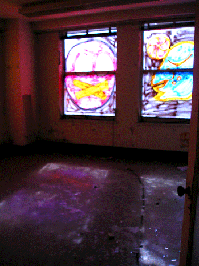
Of all the discussion about the suburban graffiti vandal, BORF, it gets down to people who see this as destruction vs. public art. Clearly the work in the United Artists Building in Detroit is at the level of art, while BORF's work, by and large is nothing but defacement, at least to me. See the previous blog entries "Beautiful(?) Decay" and "Borf(s) Nabbed." It's also been discussed in much greater length at DCist, in this piece, Opinionist: Why We'll Miss Borf's DC Occupancy.
From the Opinionist piece:
Regardless of his motivation, Borf was compelling. On our way home from work, on our way to the market, or in the minutiae of our daily lives, his scrawls and stencils encouraged us to examine "what is art" during an era dominated by terrorist talk, war games, corporate scandals, and wiretapping. With the culture wars largely shunted to politics, religion, and science, it felt refreshingly '90s to see people riled up about art and its merit or lack thereof. Why does it matter? Because art—be it highbrow or populist-- can ignite conversation, reinforce our convictions, act as a panacea, make us laugh, or generate sympathy in ways provocations in the halls of government or boardrooms may not. Regardless of whether Borf’s work is high or low, his efforts did all of these things.
I don't know. Scrawls seem more like defacement to me and the "production" of an environment that is accused of being unsafe and unseemly, and used as an excuse to denigrate center cities and the people that live within these cities.
I have a hard time seeing the connection between BORF and the "graffiti" production in the United Artists Building in Detroit.
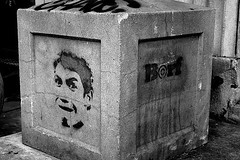
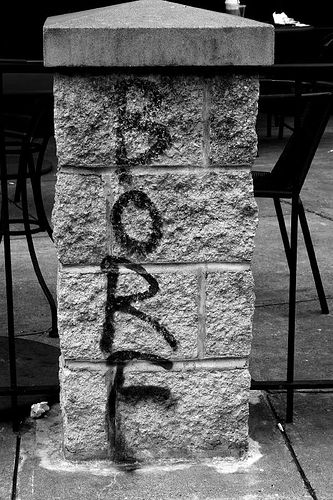 Borf photos by CharlieTakesPhotos (Flickr).
Borf photos by CharlieTakesPhotos (Flickr).Index Keywords: quality-of-life-advocacy; graffiti



0 Comments:
Post a Comment
<< Home